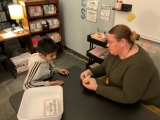-
Category 3
Selected in 2023
-
Grades: pre k - 8
School Setting: suburban
Town Population: 33,653
Student Enrollment: 584
Student Demographics:
Black/African American: 3%
Teacher/Student Ratio: 1:16
White/Caucasian: 31%
Hispanic: 45%
Hawaiian/Pacific Islander: 0%
Asian: 20%
Native American: 0.3%
Other: 0.2%
% Reduced Lunch: 70%
% ELL Learners: 20%
Founded: 1997 -
PRINCIPAL:
Louise Moore -
CONTACT:
11950 Riley st
Holland, MI 49424
616-786-2400
8.lmoore@nhaschools.com
Eagle Crest Charter Academy
Holland, MI
We have built partnerships between home, school, and parents to support our children.
- 1. Tell us about your school’s success.
-
Eagle Crest Charter Academy (EC) is a K-8 Public School located on the north side of Holland, Michigan. Our school is chartered through Central Michigan University and overseen by a board of directors made up of EC parents and community members. Eagle Crest is a diverse community of 584 students, over 100 of whom are English learners representing 23 different languages. 70% of our students qualify for free and reduced lunch, and our special education population is 12%. Our diverse population of learners experience an education based on a strong moral focus curriculum, quality core instruction, targeted intervention and high academic standards. Our students consistently outperform neighboring districts on standardized state testing. In 2019, Eagle Crest was named an Exemplary High Performing National Blue Ribbon School. Students who graduate from Eagle Crest are well prepared to excel both academically and socially in high school and beyond.
- 2. Talk about the greatest contributing factor(s) that promoted positive change in your school.
-
During the 2015-2016 school year, Eagle Crest developed a cohesive IAT (Intervention Assistance Team) process to analyze student data, identify the intervention needs of students, determine plans of intervention, and to progress monitor students’ academic growth. Our continued work and improvement in the IAT process has provided positive change in student growth, both academically and socially & emotionally.
Identified students receive targeted intervention for 4-6 weeks based on the data review and action planning of a team of professionals. Student growth is assessed during a scheduled follow up meeting, and their next step in the process is determined by their level of growth.
This IAT structure of data analysis, collaboration of professionals from a variety of specialties, progress monitoring of student growth, and follow up has resulted in the academic and behavioral growth of our students and the bridging of the gap for those who are in need of intervention.
- 3. How has ESEA funding supported the school's success?
- The allocation of ESEA funding has played a pivotal role in fostering the success of our school, as evidenced by its multifaceted impact across various crucial areas. 3 TESOL endorsed teaching staff, 2 Academic & Behavior Support Specialists, 9 instructional paraprofessionals, and a Reading and Math Academic Specialist, we are able to provide targeted intervention to increase student growth and proficiency. ESEA funding has enabled the provision of ongoing professional development opportunities. These initiatives empower teachers with the skills and strategies necessary to effectively support English learners in the classroom, thereby building overall efficacy among the teaching staff. ESEA funding after school tutoring and summer programming provides additional opportunities to close achievement gaps. ESEA funded family engagement nights provide parents with the skills and materials to work with their students at home.
- 4. What professional development activities were used to improve teaching and learning?
-
The allocation of ESEA funding has played a pivotal role in fostering the success of our school. Through ESEA funding we are able to employ staff, provide programming, purchase materials, engage families, build collective efficacy among staff, build home libraries, expand student experiences, and provide targeted intervention to identified students. ESEA funding has allowed us to close achievement gaps and foster growth of all students.. ESEA funded family engagement nights have built partnerships between home and school and provided parents with the knowledge and resources to support their child at home.
ESEA funding has been instrumental in creating a holistic and supportive educational environment, fostering success for English learner students and the entire school community. The comprehensive approach to targeted instruction, professional development, family engagement, and resource provision demonstrates the positive impact of ESEA funding on our school's overall success.
- 5. Talk about the cultural shift leading up to your school's success.
-
Over the past 10 years, the population at Eagle Crest has transitioned to a more accurate reflection of the West Ottawa school district in which it resides. Additionally, Eagle Crest has seen a continued increase in the number of English learners and an increase in the number of students who have experienced/are experiencing trauma. With this shift in demographics and student experience, teachers and staff have taken on the serious work of building a community of educators with the ability and mindset to adapt to the changing needs of our families, to provide equal opportunity for success for all students, and create a culture that embodies our moral focus curriculum. The Eagle Crest staff have been successful in their work.
The staff has built a community of learners and a positive culture for which Eagle Crest is known throughout the community. A culture built on relationships, high expectations, and systems of support is what keeps staff and families committed to Eagle Crest.
- 6. How has community involvement strengthened your success?
- Eagle Crest Charter Academy has intentionally built strong partnerships with community members and organizations. These partnerships provide academic and emotional support for our students. Hope College provides programs for our at-risk students to receive tutoring and for gifted middle school students to take high school level classes. Hope’s Step Up program provides mentoring for middle school students. Local churches provide mentoring and weekend food items through their Kids’ Hope and Hand to Hand programs. Local health organizations provide dental care and health and safety education programs. Other local organizations support and provide financing for our students to participate in programs like Girls on the Run and Trek for Tech. Our students also learn about the importance of community involvement by participating in a variety of service projects that help local families and through participation in the Tulip Time Festival each May.
Stats
-
Category 3
Selected in 2023
-
Grades: pre k - 8
School Setting: suburban
Town Population: 33,653
Student Enrollment: 584
Student Demographics:
Black/African American: 3%
Teacher/Student Ratio: 1:16
White/Caucasian: 31%
Hispanic: 45%
Hawaiian/Pacific Islander: 0%
Asian: 20%
Native American: 0.3%
Other: 0.2%
% Reduced Lunch: 70%
% ELL Learners: 20%
Founded: 1997 -
PRINCIPAL:
Louise Moore -
CONTACT:
11950 Riley st
Holland, MI 49424
616-786-2400
8.lmoore@nhaschools.com










